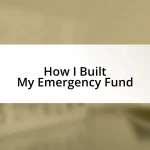Key takeaways:
- Diversifying an investment portfolio across asset classes, like stocks, bonds, and real estate, helps manage risk and stabilize returns during market fluctuations.
- Regularly assessing and adjusting investments is crucial for aligning with financial goals and minimizing emotional decision-making.
- Researching investments thoroughly and understanding local and foreign markets is important to avoid pitfalls and make informed decisions.
- Diversification not only involves spreading investments but also knowing when to exit underperforming assets to allow for better opportunities.
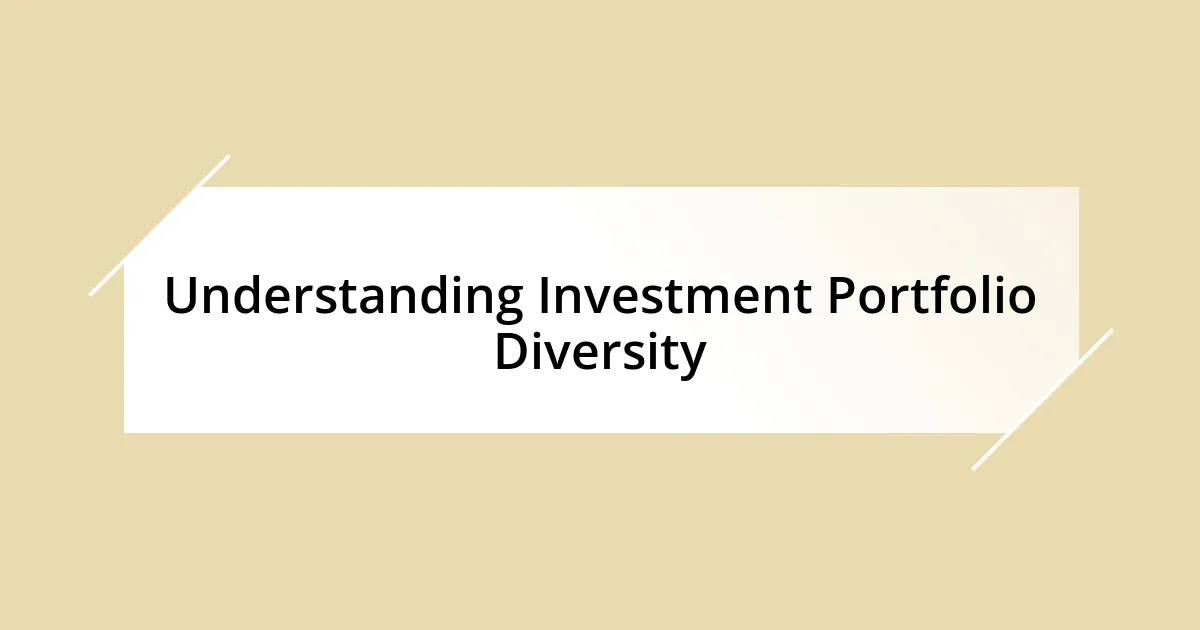
Understanding Investment Portfolio Diversity
Understanding investment portfolio diversity is crucial for managing risk and maximizing returns. When I first started investing, I remember the anxiety of seeing my money tied up in just one asset. What if that asset tanked? The very thought kept me up at night.
Diverse portfolios can include a mix of stocks, bonds, real estate, and even commodities. For me, branching out into real estate felt like a leap of faith, but watching those investments appreciate over time proved how vital it was to spread my bets. Have you ever felt the comforting weight of knowing your investments are not all in one basket? It can change your entire mindset toward investing.
I learned that not all assets respond to market conditions in the same way. For example, during an economic downturn, my stocks may have faltered, but my bonds often provided a buffer. It’s like having a safety net—one that bolsters your confidence in uncertain times. How does the thought of a more resilient portfolio resonate with you?
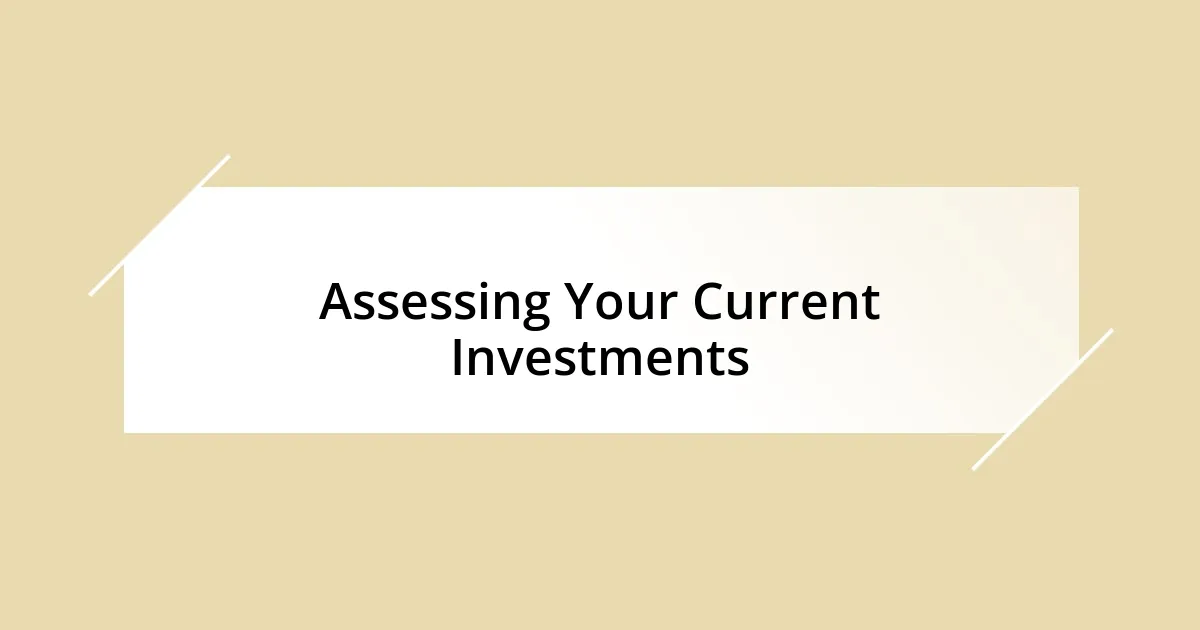
Assessing Your Current Investments
To really assess your current investments, I think it’s essential to take a close look at each asset class in your portfolio. I remember sitting down one afternoon, coffee in hand, to break down what I had on paper. It was eye-opening to see how much I relied on just a couple of stocks. I encourage you to dig into your investments and ask yourself the tough questions.
- What percentage of my investment portfolio is in stocks, bonds, mutual funds, or other assets?
- How have my investments performed over the past year?
- Are there any assets that have consistently underperformed?
- How do my investments align with my financial goals and risk tolerance?
- Am I overexposed to any particular market sector or asset class?
This exercise not only highlights areas of concern but also reveals opportunities for further diversification. I felt empowered when I recognized where I needed to make adjustments; it’s a pivotal step many overlook.
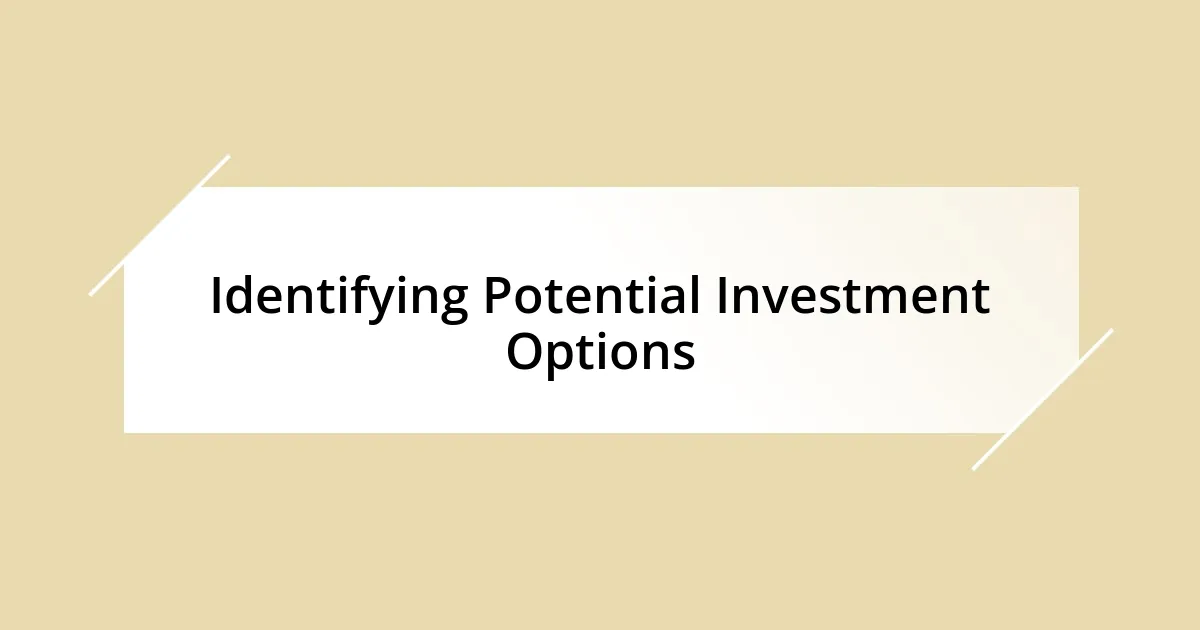
Identifying Potential Investment Options
When I set out to identify potential investment options, I found that exploring different asset classes opened my eyes to a world of possibilities. Initially, I focused heavily on stocks, but soon realized that other investment types could provide both security and growth. Have you ever considered how much variety exists beyond what’s commonly known? For instance, real estate and index funds became my go-to options after I experienced the slow but steady returns they brought.
One thing I learned is the importance of researching each investment thoroughly. I started attending investment seminars and reading industry newsletters. At first, it felt overwhelming, but gradually, I became more comfortable filtering through the noise to find valuable insights. I remember discovering a small tech company that was gaining traction. Investing a little there transformed my portfolio in a way I hadn’t expected. Every market phase has opportunities; it’s just about recognizing them.
After this exploration, I began looking closely at alternative investments like peer-to-peer lending and fine art. These options might seem unconventional, but they blend well into a well-rounded portfolio. I recall taking a chance on a crowdfunding real estate project, and watching the community grow around it was rewarding. It made me realize that some of the most valuable investments can emerge from thinking outside the traditional parameters.
| Investment Type | Characteristics |
|---|---|
| Stocks | High-risk, high-reward, subject to market volatility |
| Bonds | Steady income, typically lower risk, less return |
| Real Estate | Potential for appreciation and rental income, requires management |
| Mutual Funds | Diversified, managed investment option, fees apply |
| Peer-to-Peer Lending | Higher potential returns, risk of borrower default |
| Fine Art | Illiquid, potential for significant appreciation, unique and subjective |
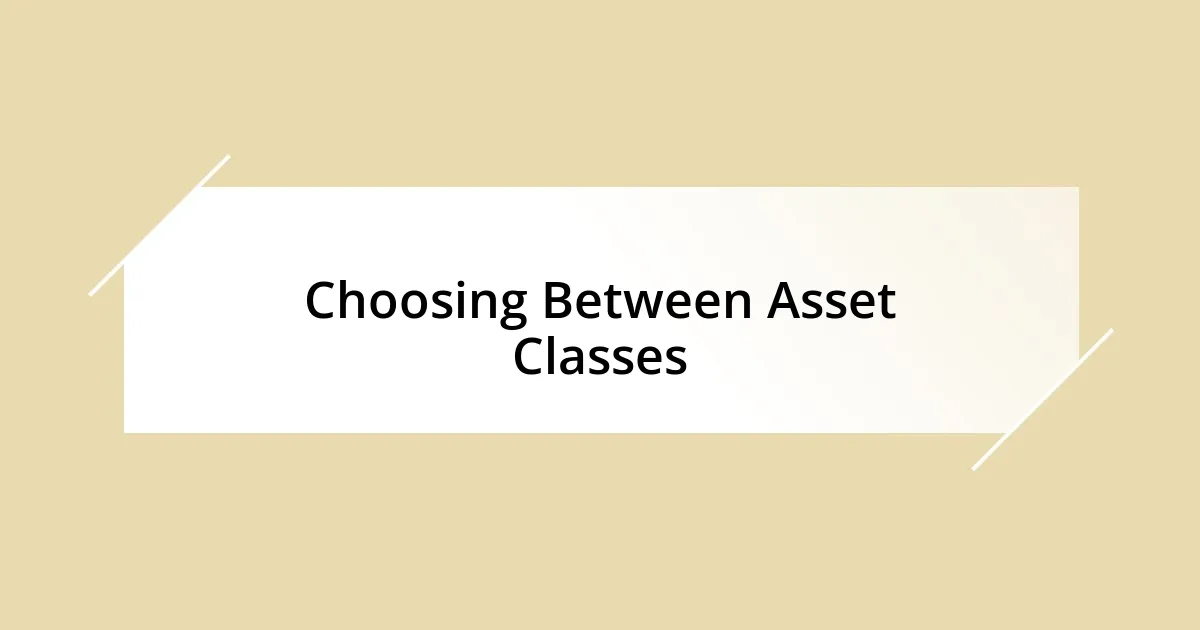
Choosing Between Asset Classes
Choosing the right asset classes can feel daunting, especially when you’re looking to diversify your portfolio. I remember grappling with whether to invest in stocks or bonds. My gut instinct was to lean toward stocks because of their potential for higher returns, but I quickly realized that including bonds offered a safety net. Have you ever felt that tug between the desire for growth and the need for stability?
As I navigated these choices, I discovered the significance of aligning asset classes with my personal risk profile. For example, I found that while I enjoyed the thrill of tech stocks, my heart sank whenever the market dipped. Realizing I could have a balanced approach was liberating; I began incorporating safer investments like bonds and dividend-paying stocks. It felt like creating a safety net while still chasing after growth. How do you balance risk versus reward in your investment strategy?
Diving deeper into alternative asset classes was another pivotal moment for me. When I stumbled upon a local real estate investment group, I saw firsthand how investing in properties could generate steady cash flow. The excitement of being part of something tangible made me rethink my investment strategy. It made me ask myself—what unique assets can I include that resonate with my values and interests? That sense of connection led me to explore investments that ignited my passion, which was an unexpected but rewarding shift in my portfolio.
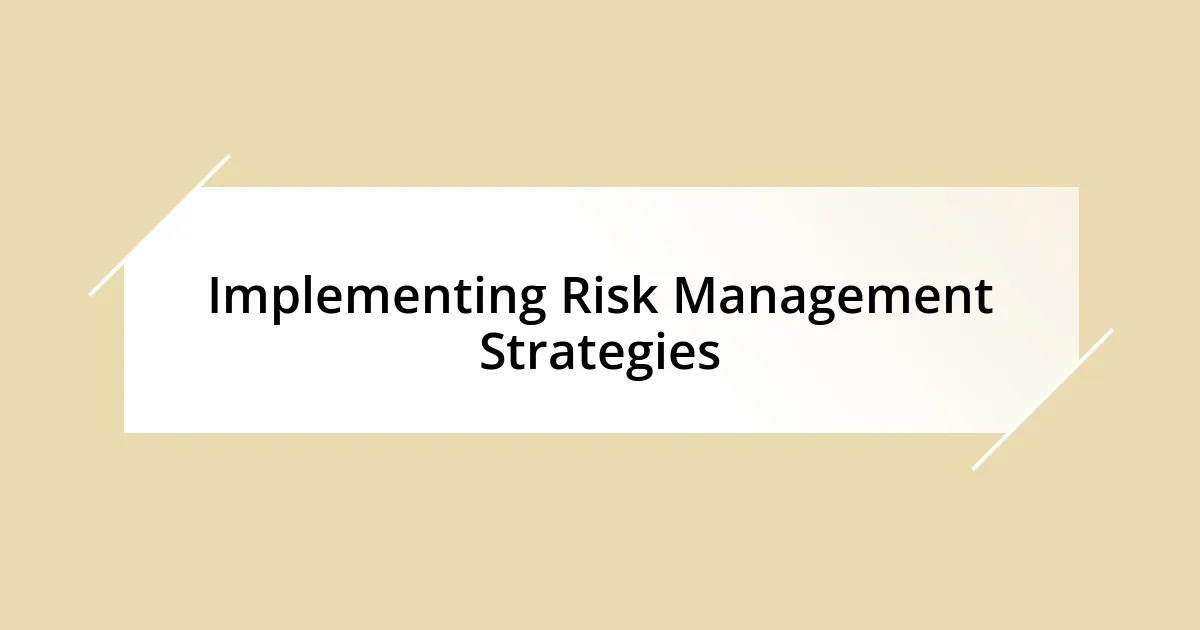
Implementing Risk Management Strategies
Implementing risk management strategies is crucial for maintaining a balanced investment portfolio. One of the first steps I took was to establish a diversified asset allocation that reflected my risk tolerance. I remember vividly the moment I realized the value of not putting all my eggs in one basket. By investing across different asset classes, like stocks, bonds, and real estate, I was able to cushion my portfolio against unexpected market fluctuations.
Another important strategy I adopted was setting aside an emergency fund specifically for investments. This fund acts as a financial buffer, allowing me to weather downturns without needing to liquidate assets at a loss. Have you ever felt that sinking feeling when a market crash looms? Knowing I had a safety net in place eased my anxiety during those times, letting me stick to my long-term strategy instead of making rash decisions driven by fear.
Lastly, I embraced the concept of regular portfolio reviews and rebalancing. It’s an ongoing process that ensures my investments align with my risk management goals. I recall when I realized some of my higher-risk assets had outperformed others, leading me to unintended overexposure. By taking the time to rebalance my portfolio, I not only mitigated risk but also reinforced my commitment to a strategy that values both security and growth. Isn’t it fascinating how a little adjustment can make a significant difference in the long run?

Monitoring and Adjusting Your Portfolio
Monitoring my portfolio is something I find both enlightening and a bit nerve-wracking. Each quarter, I carve out time to dive into my investments and assess their performance. I remember the first time I did this; I was astounded to see how certain stocks had soared while others lagged behind. Have you ever experienced that moment of surprise, when your expectations don’t match reality? It taught me the importance of regularly checking in, as this practice empowers me to stay informed and proactive.
Adjusting my portfolio isn’t just a strategy; it feels like a reflection of my financial journey. There was a time when my favorite tech stocks took a dive due to market volatility. It was tempting to hold on and hope for a turnaround. Instead, I chose to sell some shares and invest in stable, income-generating assets like dividend aristocrats. This shift not only cushioned my losses but also reminded me that adaptability is key. How do you handle your emotions when the market throws curveballs at you?
I’ve learned that the process of monitoring and adjusting extends beyond mere numbers. It’s about understanding the story behind each investment. During one of my reviews, I noticed I had developed a strong attachment to a few underperforming stocks. Letting go was tough! Yet, realizing that holding on could hinder my overall growth was a wake-up call. How often do we let emotions dictate our investment decisions? By learning to detach, I’ve fostered a healthier relationship with my portfolio, allowing me the freedom to embrace opportunities as they arise.
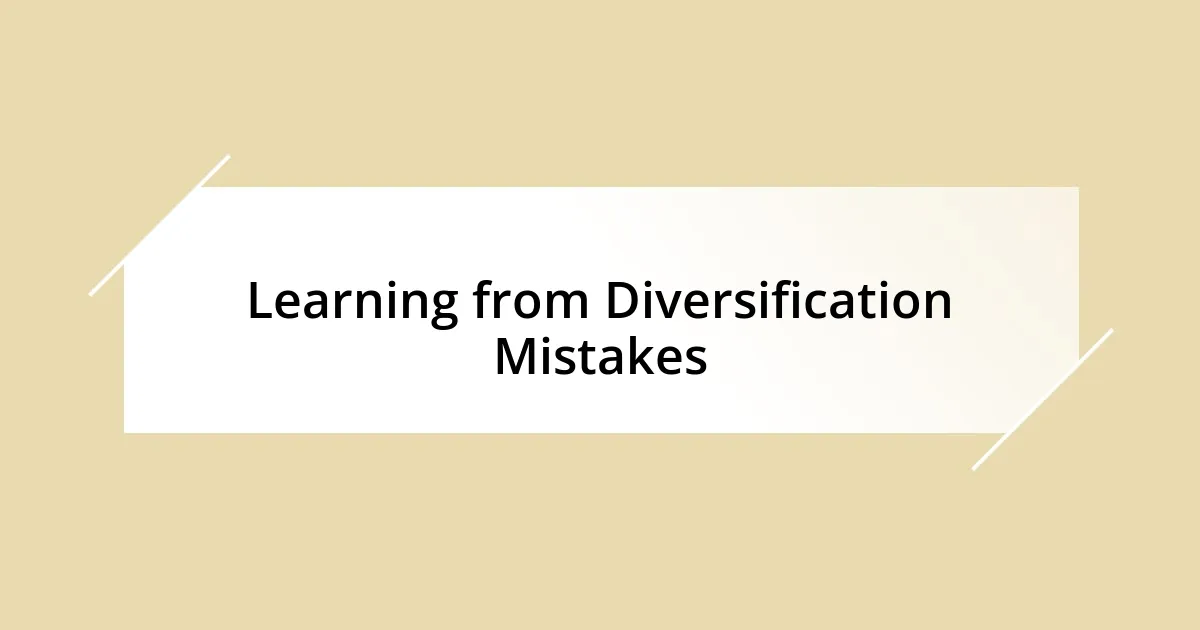
Learning from Diversification Mistakes
Reflecting on my journey through diversification, I’ve stumbled into a few pitfalls that taught me valuable lessons. One particularly memorable mistake was investing heavily in a trendy tech startup without sufficient research. I thought I was being smart and forward-thinking, but when the company fell short of its projections, my portfolio took a hit. Have you ever jumped on a bandwagon only to find out it was rolling in the wrong direction? It underscored the importance of due diligence and how hype can sometimes overshadow sound investment principles.
There was another moment that stands out: I overcommitted to international funds, hoping to capitalize on emerging markets. Initially, it felt like a golden opportunity, but when geopolitical tensions simmered and affected my returns, I realized my mistake. It was a wake-up call to balance my investments with a mix of familiar and foreign opportunities. How often do we forget that understanding local markets can be just as crucial? This experience led me to diversify not only across asset classes but also geographically, seeking balance and stability instead of chasing the latest trends.
Lastly, I learned that diversification isn’t solely about distributing investments across various assets; it also means knowing when to exit. There was a time when I clung to an underperforming bond fund, believing it would eventually rebound. I felt an emotional attachment—almost like a bad relationship! It took a long, hard look at my financial goals to finally let it go, clearing the space for better options. Have you ever held on too long, hoping things would improve? This taught me a big lesson: sometimes, moving on is just as important as diversifying.













